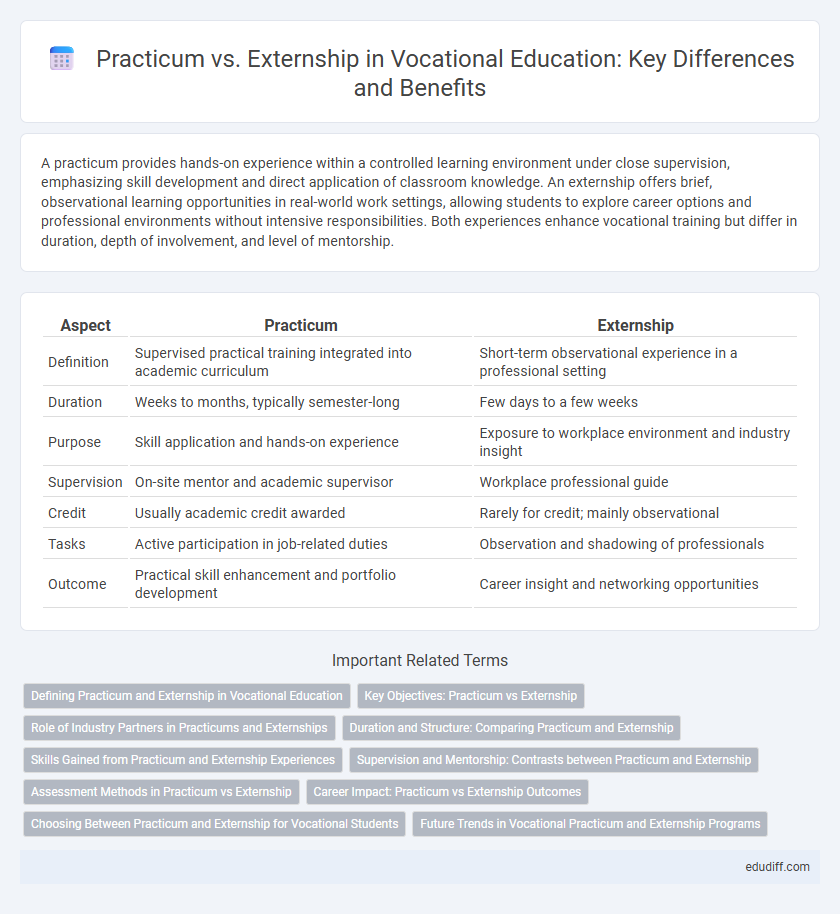A practicum provides hands-on experience within a controlled learning environment under close supervision, emphasizing skill development and direct application of classroom knowledge. An externship offers brief, observational learning opportunities in real-world work settings, allowing students to explore career options and professional environments without intensive responsibilities. Both experiences enhance vocational training but differ in duration, depth of involvement, and level of mentorship.
Table of Comparison
| Aspect | Practicum | Externship |
|---|---|---|
| Definition | Supervised practical training integrated into academic curriculum | Short-term observational experience in a professional setting |
| Duration | Weeks to months, typically semester-long | Few days to a few weeks |
| Purpose | Skill application and hands-on experience | Exposure to workplace environment and industry insight |
| Supervision | On-site mentor and academic supervisor | Workplace professional guide |
| Credit | Usually academic credit awarded | Rarely for credit; mainly observational |
| Tasks | Active participation in job-related duties | Observation and shadowing of professionals |
| Outcome | Practical skill enhancement and portfolio development | Career insight and networking opportunities |
Defining Practicum and Externship in Vocational Education
A practicum in vocational education is a supervised, hands-on training experience where students apply theoretical knowledge in a real work environment, often within the educational institution or partnered organizations. An externship offers short-term, observational learning placements allowing students to gain exposure to professional settings, typically without direct job responsibilities. Both practicum and externship programs enhance practical skills, but practicums emphasize active participation while externships focus on observation and industry familiarization.
Key Objectives: Practicum vs Externship
Key objectives of a practicum include gaining supervised, hands-on experience within a structured academic framework to apply theoretical knowledge, develop technical skills, and meet specific learning outcomes. Externship objectives focus on short-term exposure to real-world work environments, enhancing professional networking, career exploration, and understanding workplace dynamics. Both practicum and externship aim to bridge classroom learning with practical application but differ in duration, intensity, and level of academic supervision.
Role of Industry Partners in Practicums and Externships
Industry partners play a crucial role in both practicums and externships by providing real-world work environments where students apply theoretical knowledge. In practicums, these partners often closely collaborate with educational institutions to offer supervised, hands-on experience tailored to specific curriculum goals. Externships typically involve shorter, observational opportunities, allowing industry partners to mentor students and expose them to workplace culture and professional expectations.
Duration and Structure: Comparing Practicum and Externship
Practicums typically span several weeks to months, offering a structured, supervised learning experience integrated with coursework, emphasizing skill development through direct application. Externships usually have shorter durations, often one to two weeks, providing brief, observational opportunities focused on exposure to professional environments without intense supervision. Both play essential roles in vocational training, but practicums are more immersive and hands-on, whereas externships prioritize observational learning and networking.
Skills Gained from Practicum and Externship Experiences
Practicum experiences provide hands-on training that develops practical skills such as patient care, technical procedures, or educational techniques within a supervised setting. Externships offer observational learning followed by limited direct involvement, enhancing professional behavior, workplace communication, and industry-specific knowledge. Both experiences are critical for vocational students to build competence and confidence required for entry-level positions.
Supervision and Mentorship: Contrasts between Practicum and Externship
Practicums typically involve direct supervision by an on-site professional who provides structured guidance and regular feedback to ensure skill development in a controlled environment. Externships offer less intensive supervision, emphasizing observational learning and real-world exposure under the mentorship of experienced practitioners. This distinction highlights practicums as more hands-on and instructional, while externships focus on experiential learning with mentorship support.
Assessment Methods in Practicum vs Externship
Practicum assessment methods primarily involve continuous evaluation through direct observation, reflective journals, and supervisor feedback, ensuring students apply theoretical knowledge in real-world settings. Externship assessment focuses more on performance-based evaluation, including task completion, professionalism, and adaptability within a host organization's work environment. Both methods emphasize practical skills, but practicum assessments integrate academic criteria while externship evaluations prioritize workplace readiness and industry standards.
Career Impact: Practicum vs Externship Outcomes
Practicums offer hands-on experience by integrating academic knowledge with real-world tasks, enhancing practical skills directly related to specific vocations. Externships often provide brief, observational experiences that expand professional networks and expose students to workplace culture without extensive responsibility. Career impact is significantly influenced by practicums' depth of engagement, which typically leads to stronger resumes and higher employability compared to the more introductory nature of externships.
Choosing Between Practicum and Externship for Vocational Students
Vocational students must evaluate learning objectives and career goals when choosing between practicum and externship, as practicums offer structured, supervised training integrated with academic coursework, whereas externships provide short-term, observational experiences often outside the classroom. Practicums are ideal for hands-on skill development in a controlled environment, while externships expose students to real-world industry settings and professional networking opportunities. Selecting the appropriate option depends on the required level of practical skill practice and desired exposure to workplace dynamics in the chosen vocational field.
Future Trends in Vocational Practicum and Externship Programs
Future trends in vocational practicum and externship programs emphasize increased integration of digital technology and virtual learning environments to enhance hands-on experience remotely. Personalized learning pathways powered by AI algorithms are being developed to match students with industry-specific opportunities, optimizing skill acquisition and job readiness. Partnerships between educational institutions and employers are expanding to create more adaptive, real-world training scenarios that meet evolving market demands.
Practicum vs Externship Infographic

 edudiff.com
edudiff.com